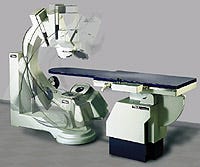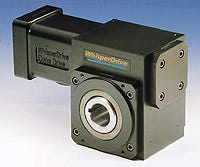September 1, 1998
 Case Histories in Medical Device Manufacture
Case Histories in Medical Device Manufacture
Drive System Eliminates Vibration Problem in Imaging Device
Controlling backlash essential for accurate electrophysiology imaging.
In engineering any new product, the key to success is being able to respond quickly to design problems with innovative and efficient solutions. Such was the challenge for the engineers at Trex Medical Corp., Continental Div., (Broadview, IL), in developing the CardioArc L/C positioner for use in their new EP 2000 electrophysiology imaging system.
Electrophysiology (EP) is a diagnostic procedure that determines the nature and extent of cardiac arrhythmia. Spurred by the success of two treatment therapies using electrophysiology imaging—implantable cardioverter defibrillators and RF catheter ablation—the market for EP imaging systems is growing rapidly.
To tap into this market, Trex Medical, a developer of diagnostic imaging, created the EP 2000 to provide electrophysiologists with a wide imaging range without interference from the positioner. To accomplish this, the system features a unique floor-mounted isocentric three-axis L/C positioner called the CardioArc. Shaped like a C, the design allows for imaging from the right or left side of the table to provide unobstructed access to the patient's head. The CardioArc has two joysticks controlling three motorized motions (rotational from the center point of the C, a main rotation axis at the base, and a horizontal slide movement) to provide PA, LAO, RAO, C/C, and lateral views for catheter positioning.
 The EP 2000 electrophysiology imaging system with its C-shaped CardioArc isocentric L/C positioner.
The EP 2000 electrophysiology imaging system with its C-shaped CardioArc isocentric L/C positioner.
The system works by having the patient recline on the tilting/elevating table. At one end of the CardioArc is a high-frequency x-ray generator with a variable pulsed fluoroscope. At the other end is a high-resolution cardiac imaging system and a 1023 progressive-scan TV camera.
To power the movements of the CardioArc, Trex first tried using dc direct drive through a dc motor controller. However, a high degree of backlash caused the entire device to vibrate significantly. In order to provide vibration-free movement of the CardioArc and to ensure highly accurate imaging, it was essential to find a way to control the drive system backlash.
"The biggest problem we faced was that the vibration was inherent to the gear reducer we were using," says Steve Talbert, a mechanical engineer for Trex Medical. "Our only way around the problem was to find another reducer, one that would provide zero backlash and quiet operation."
 The WhisperDrive zero-backlash gearhead allows the CardioArc's movements to be vibration-free.
The WhisperDrive zero-backlash gearhead allows the CardioArc's movements to be vibration-free.
Cone Drive (Traverse City, MI), a manufacturer of precision drive systems, offered a solution with its WhisperDrive. This quiet running, zero-backlash servo gearhead employs double-enveloping worm gearing to provide the highest possible degree of positioning accuracy and smooth operation.
Given the unique shape of the CardioArc and its relation to the other components of the EP 2000 system, there was a very limited area in which the WhisperDrive could be incorporated. Fortunately, the WhisperDrive was roughly the same size as the component that Trex had previously used. "The mounting was slightly different, but not significantly," says Talbert. "We were able to incorporate the new drive by using a different mounting bracket without having to reengineer the space."
The lesson learned from integrating the WhisperDrive into the CardioArc L/C positioner can be applied to various other devices, as more and more applications are extremely intolerant to even the lowest backlash levels. To accommodate these applications, the WhisperDrive provides a high degree of position accuracy to ensure consistent, high-quality operation.
You May Also Like


